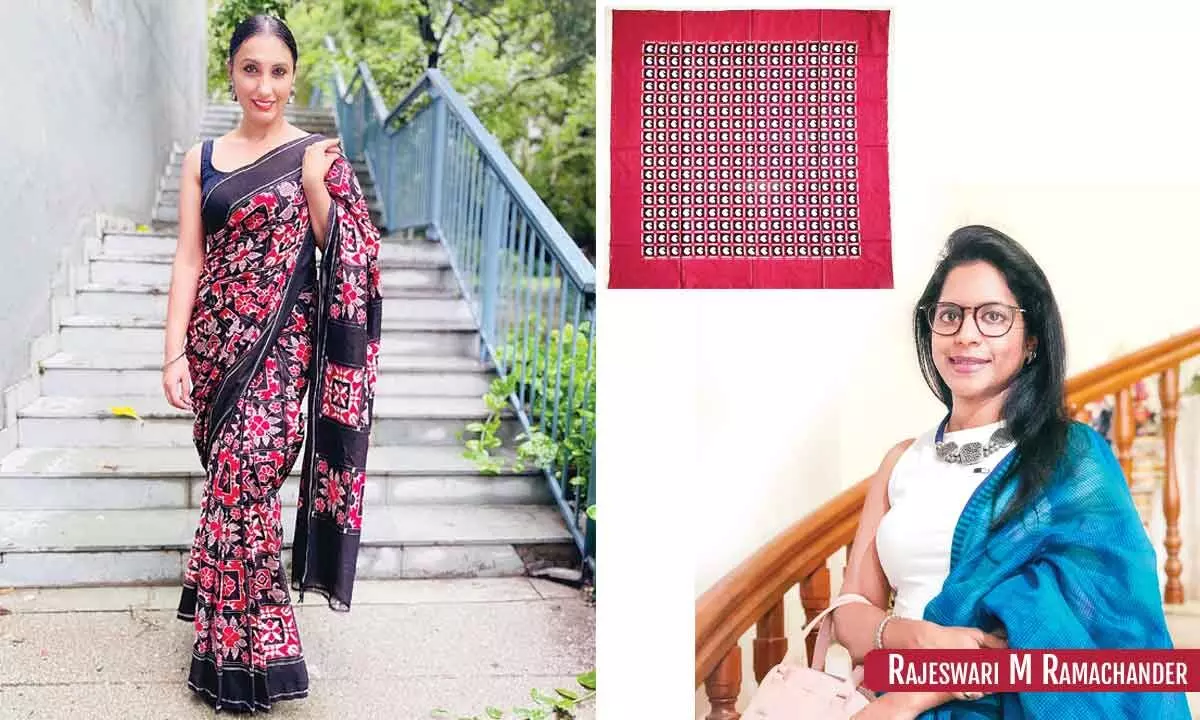Live
- Telugu Desam Party Welcomes several Families into party
- Future of the State in Question under YCP Rule: Kavali NDA Alliance Candidate
- Massive Bike Rally in Kaikalur Constituency for unity of yadavs
- BS Maqbool's Son BS Akhil Urges Voters to Support Party in Election Campaign
- Volunteers from 29th Division Resign in Support of Jagan Mohan Reddy Government
- Exciting promo of ‘Sarkaar Season 4’ unveiled; Sudigali Sudheer comes on board
- MLA Vasantha Krishnaprasad Leads Door-to-Door Campaigning in Kondapalli Municipality
- Aadi Saikumar announces his next titled ‘Krishna from Brindavanam’
- Pothuganti Bharath Prasad filed nomination as Nagar Kurnool Lok Sabha candidate
- MLA Namburu Shankara Rao Welcomes Muslim Brothers to YSRCP
Just In

Eeshita Joneja in Telia Rumal woven by master weaver Gajan Govardhan(Left); Telia Rumal by Gajam Govardhan
In the 1950s, the weavers of Puttapaka produced a multi-purpose square fabric that could be used as a lungi, shoulder cloth or as a turban. It was Kamaladevi that nudged the weavers to work on three sarees and paid them a handsome sum of 120 rupees, thus turning the mystery behind Telia Rumal and Ikat into history
There is little documented evidence about the invention of the Telia Rumal technique, but the credit of discovering this hidden gem in the heartland of Nizam must go to Kamaladevi Chttopadhyay. A few years after independence, Kamaladevi, a freedom fighter, entrepreneur, reformer, feminist, was mesamarised by the minimalistic design and versatile nature of a wet towel draped around the head. She'd soon follow her passion to create a new line in fashion.
Competing with the rising mercury, she raised the engine and drove through the dusty streets of Andhra Pradesh to track down the weavers behind Telia Rumal. In the 1950s, the weavers of Puttapaka produced a multi-purpose square fabric that could be used as a lungi, shoulder cloth or as a turban. It was Kamaladevi that nudged the weavers to work on three sarees and paid them a handsome sum of 120 rupees, thus turning the mystery behind Telia Rumal and Ikat into history.
Today, both Pochampally and Telia Rumal ikat sarees are chartbusters. Although, we say it in one breath, Telia Rumal weavers, who are 40 km away from Pochampally, practice a distinctive tie-dying technique in creating unique motifs of Telia Rumal. And deservingly, this UNESCO-recognised cluster of Puttapaka got its GI tag a few months ago. No wonder the weavers were busy, meeting the demand even during the lockdown.
We can learn that the weave 'Telia rumal', translated as oily kerchief, got its name because of its making. The weave has an oily texture because it involves wetting and kneading of the cotton yarns in oil, a preparatory step for dyeing. The yarn is then soaked in ginger oil and dung for 21 days. And only then the dyeing process starts. Despite its intricate pattern, the weave was not to the taste of the aristocrats of those times.
It is said that the only takers of this produce were the poor fishermen that needed a sturdy cloth for their lifestyle. Slowly but surely, the cloth found customers in the faraway lands. The telia rumal fabric is known to keep the body cool in warm temperatures and warm in cold temperatures, thus making it an ideal sartorial choice to those who lived in Arabia. Later, the royals of Nizam accepted this Ikat fabric that was worn as a dupatta with heavy embroidery on it.
In the subsequent years, the weave earned a special place in the wardrobe of those who lived in Delhi. Martand Singh and Pupul Jayakar made efforts to popularise the weave. It would soon be displayed in international and national exhibitions. And, the Crafts Council of India did its part to bring home the trophy to the Telugu land.
Ikat. So, what is in the name?
It takes highly skilled weavers to work on an ikat fabric of Puttapaka. Unlike other weaves, ikat involves a lot of steps and needs many weavers to accomplish this job. Even today, it is not uncommon to see the entire family work on a single saree. The making begins with a design drawn on graph paper, followed by the preparation of yarn. As mentioned earlier, for Telia Rumal, the yarn is soaked in ginger oil and dung for 21 days. These yarns are wrapped according to the patterns designed on the graph paper. Now, it's time for an important step: the resist dye. In this step, one by one, each yarn is resisted according to pattern and colour, thus unveiling a beautiful ikat fabric.
We may want to note that both warp and weft yarns are tie-dyed for a telia rumal weave, giving it a name double ikat. The good news is telia rumal is easy to identify. The original colours of Telia rumal were shades of red, blue and black on a white unbleached cotton. Traditionally, alizarian is used for red and indigo to get black or blue colour. The weave is known for its distinct geometric designs and signature plain red border enclosing its designs.
At the same time, it is interesting to know that Puttapaka's motifs are inspired by its Patan Patola counterpart. In fact, it is believed that two brothers from Chirala were trained in Gujarat, during the early 20th century. This may explain why the Pochampally and Chirala areas are known for the production of imitation patan patola sarees and the influence of Patan Patola weave on this region's design and motifs. Isn't imitation the best form of flattery? Well… so be it.
(The writer is a handloom and handicraft enthusiast. She is also a member of crafts council. Instagram handle: Rajeswariramachander)

© 2024 Hyderabad Media House Limited/The Hans India. All rights reserved. Powered by hocalwire.com







